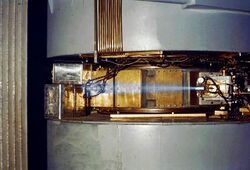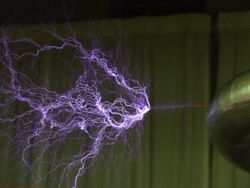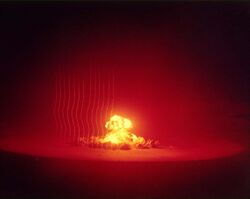Astronomy:Ionized-air glow

Ionized-air glow is the luminescent emission of characteristic blue–purple–violet light, often of a color called electric blue, by air subjected to an energy flux either directly or indirectly from solar radiation.[1]
Processes
When energy is deposited in air, the air molecules become excited. As air is composed primarily of nitrogen and oxygen, excited N2 and O2 molecules are produced. These can react with other molecules, forming mainly ozone and nitrogen(II) oxide. Water vapor, when present, may also play a role; its presence is characterized by the hydrogen emission lines. The reactive species present in the plasma can readily react with other chemicals present in the air or on nearby surfaces.
Deexcitation of nitrogen
The excited nitrogen deexcites primarily by emission of a photon, with emission lines in ultraviolet, visible, and infrared band:
- N2* → N2 + hν
The blue light observed is produced primarily by this process.[2] The spectrum is dominated by lines of single-ionized nitrogen, with presence of neutral nitrogen lines.
Deexcitation of oxygen
The excited state of oxygen is somewhat more stable than nitrogen. While deexcitation can occur by emission of photons, the more probable mechanism at atmospheric pressure is a chemical reaction with other oxygen molecules, forming ozone:[2]
- O2* + 2 O2 → 2 O3
This reaction is responsible for the production of ozone in the vicinity of strongly radioactive materials and electrical discharges.
Occurrence
Excitation energy can be deposited in air by a number of different mechanisms:
- Ionizing radiation is the cause of blue glow surrounding sufficient quantities of strongly radioactive materials in air, e.g. some radioisotope specimens (e.g. radium or polonium), particle beams (e.g. from particle accelerators) in air, the blue flashes during criticality accidents, and the eerie/low brightness "purple" to "blue" glow enveloping the mushroom cloud during the first several dozen seconds after nuclear explosions near sea level. This post-explosion effect has been observed only at night from atmospheric nuclear tests owing to its low brightness, with observers noticing it following the pre-dawn Trinity nuclear test,[3][4][5][6] as well as Upshot-Knothole Annie,[citation needed] Operation Fishbowl,[7] and the Cherokee shot of Operation Redwing.[8][9]
- Within minutes after the steam explosion that caused the Chernobyl accident at 01:23 local time, a number of employees at the power station went outside to get a clearer view of the extent of the damage. One such survivor, Alexander Yuvchenko, recounts that once he stopped outside and looked up towards the reactor hall he saw a "very beautiful" laser-like beam of light bluish light, caused by the ionization of air, that appeared to be "flooding up into infinity".[10][11]
- Cathode rays in air produce this blue glow.[12]
- Electrical discharge in air is the cause of blue light emitted by electric sparks, lightning, and corona discharges (e.g. St. Elmo's fire).
- Auroras, the sometimes observable blue-violet hues emitted by nitrogen at lower altitudes
Colors
In dry air, the color of produced light (e.g. by lightning) is dominated by the emission lines of nitrogen, yielding the spectrum with primarily blue emission lines. The lines of neutral nitrogen (NI), neutral oxygen (OI), singly ionized nitrogen (NII) and singly ionized oxygen (OII) are the most prominent features of a lightning emission spectrum.[13] Neutral nitrogen radiates primarily at one line in the red part of the spectrum. Ionized nitrogen radiates primarily as a set of lines in the blue part of the spectrum.[14]
A violet hue can occur when the spectrum contains emission lines of atomic hydrogen. This may happen when the air contains high amount of water, e.g. with lightnings in low altitudes passing through rain thunderstorms. Water vapor and small water droplets ionize and dissociate easier than large droplets, therefore have higher impact on color.[citation needed]
The hydrogen emission lines at 656.3 nm (the strong H-alpha line) and at 486.1 nm (H-beta) are characteristic for lightnings.[15] Rydberg atoms, generated by low-frequency lightnings, emit at red to orange color and can give the lightning a yellowish to greenish tint.(confusing?)[citation needed] Generally, the radiant species present in atmospheric plasma are N2, N2+, O2, NO (in dry air) and OH (in humid air). The temperature, electron density, and electron temperature of the plasma can be inferred from the distribution of rotational lines of these species. At higher temperatures, atomic emission lines of N and O, and (in presence of water) H, are present. Other molecular lines, e.g. CO and CN, mark the presence of contaminants in the air.[16]
Ionized air glow vs Cherenkov radiation
The emission of blue light is often attributed to Cherenkov radiation.[8][verification needed] Cherenkov radiation is produced by charged particles which are traveling through a dielectric substance at a speed greater than the speed of light in that medium. Despite the production of similarity-colored light and an association with high-energy particles, Cherenkov radiation is generated by a fundamentally different mechanism.[citation needed]
See also
References
- ↑ "Airglow". https://www.albany.edu/faculty/rgk/atm101/airglow.htm.
- ↑ 2.0 2.1 Wiberg, Egon; Wiberg, Nils; Holleman, Arnold Frederick (2001). Inorganic chemistry (1st English ed.). San Diego, Calif.: Academic Press. p. 1655. ISBN 0-12-352651-5.
- ↑ Goodstein, David L.; Goodstein, Judith R. (2013). Robert F. Christy: 1916–2012. Biographical Memoirs. National Academy of Sciences. p. 7. http://www.nasonline.org/publications/biographical-memoirs/memoir-pdfs/christy-robert.pdf.
- ↑ "A Backward Glance: Eyewitnesses to Trinity". Nuclear Weapons Journal (Los Alamos National Laboratory) (2): 45. 2005. LALP-05-067. http://www.lanl.gov/science/weapons_journal/wj_pubs/11nwj2-05.pdf. Retrieved 18 February 2014.
- ↑ "Christy, Robert F. Interview by Sara Lippincott. Pasadena, California, June 15, 17, 21, and 22, 1994". Oral History Project, California Institute of Technology Archives. 1998. p. 55. https://resolver.caltech.edu/CaltechOH:OH_Christy_R.
- ↑ Christy, Robert (July 6, 2017). The Trinity Test: 'An eery and awesome sight' (9/20) (Video). Web of Stories - Life Stories of Remarkable People. Event occurs at 1'47". Archived from the original on 2021-12-15 – via YouTube.
- ↑ Operation Dominic I: 1962 (Report). Defense Nuclear Agency. p. 247. DNA 6040F. https://massless.info/images/1962_DNA_6040F.pdf.
- ↑ 8.0 8.1 Cherokee Field Report Bikini Operations, page 10, quoted in Hansen, Chuck (1995). The swords of Armageddon: U.S. nuclear weapons development since 1945. Sunnyvale, Calif.: Chukelea Publications. 1307. OCLC 1109685186.
- ↑ Bethge, Philip (2010-11-25). "Mushroom Clouds and Everpresent Danger: Surviving Cameramen Recall Nuclear Test Shots". Der Spiegel. https://www.spiegel.de/international/world/mushroom-clouds-and-everpresent-danger-surviving-cameramen-recall-nuclear-test-shots-a-730985.html. "[Photographer George Yoshitake said] 'For several minutes after the blast, you could see this eerie ultraviolet glow high up in the sky. And I thought that was so spectacular, so meaningful.' "
- ↑ Meyer, C. M. (March 2007). "Chernobyl: what happened and why?". Energize (Muldersdrift, South Africa): 41. ISSN 1818-2127. http://www.eepublishers.co.za/images/upload/Meyer%20Chernobyl%205.pdf.
- ↑ Bond, Michael (21 August 2004). "Cheating Chernobyl". New Scientist 183 (2461): 46. ISSN 0262-4079. https://www.newscientist.com/article/mg18324615-300-cheating-chernobyl/.
- ↑ Strutt, R. J. (2004). The Becquerel rays and the properties of radium. Mineola, N.Y.: Dover Publications. p. 20. ISBN 0-486-43875-9.
- ↑ Uman, Martin A. (1984). Lightning. Dover Publications. p. 139. ISBN 0-486-64575-4. https://archive.org/details/trent_0116300718198/mode/1up.
- ↑ Uman, Martin A. (1986). All about lightning. Dover Publications. p. 96. ISBN 0-486-25237-X. https://archive.org/details/allaboutlightnin0000uman/mode/1up.
- ↑ Orville, Richard E. (1980). "Daylight Spectra of Individual Lightning Flashes in the 370–690 nm Region". Journal of Applied Meteorology and Climatology 19 (4): 470–473. doi:10.1175/1520-0450(1980)019<0470:DSOILF>2.0.CO;2. Bibcode: 1980JApMe..19..470O.
- ↑ Laux, C. O.; Spence, T. G.; Kruger, C. H.; Zare, R. N. (2003). "Optical diagnostics of atmospheric pressure air plasmas". Plasma Sources Science and Technology 12 (2): 125. doi:10.1088/0963-0252/12/2/301. Bibcode: 2003PSST...12..125L. https://www-leland.stanford.edu/group/Zarelab/publinks/725.pdf.
 |





